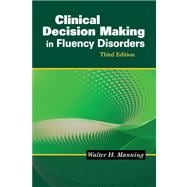
| The Clinician and the Therapeutic Process | |
| Chapter Objectives | |
| The Effective Clinician | |
| The Importance of the Clinician | |
| Clinician Attitudes About Stuttering and People Who Stutter | |
| Investigations of Clinical Preparation | |
| How Clinicians Interpret the Disorder | |
| Clinician Personality Attributes | |
| Clinician Intervention Skills | |
| Becoming Less Inhibited as a Clinician | |
| Avoiding Dogmatic Decisions | |
| Opening Your Treatment Focus | |
| Calibrating to the Client | |
| Observing Silence | |
| Modeling Risk Taking | |
| Challenging the Client | |
| Developing Expertise: Implications for Clinicians | |
| Decision Making with Rules and Principles | |
| Specialty Recognition in Fluency Disorders | |
| Humor and the Clinician | |
| An Historical Perspective | |
| Acknowledging Humor During Therapeutic Change | |
| The Conceptual Shift | |
| Distancing With Humor | |
| Mastery and Humor | |
| Conclusion | |
| Topics for Discussion | |
| Recommended Readings | |
| The Nature of Fluent and Nonfluent Speech: The Onset of Stuttering | |
| Chapter Objectives | |
| The Characteristics of Normal Fluency | |
| Fluency in Adult Speakers | |
| Defining Stuttering and Related Terms | |
| Definitions of Stuttering | |
| Distinguishing Stuttering from Normal Fluency Breaks | |
| The Speakers Loss of Control | |
| The Fluency Breaks of Children | |
| Characteristics at the Onset of Stuttering | |
| Age and Gender | |
| Rate and Uniformity of Onset | |
| Stuttering-Like Disfluencies | |
| Clustering of Disfluencies | |
| Awareness and Reaction of the Child to Disfluency | |
| Conditions Contributing to Onset | |
| More Influential Factors | |
| Age | |
| Gender | |
| Genetic Factors | |
| Twinning | |
| Cognitive Abilities | |
| Motor Abilities | |
| Speech and Language Development | |
| Response to Emotional Events | |
| Less Influential Factors | |
| Physical Development and Illness | |
| Culture, Nationality and Socioeconomic Status | |
| Bilingualism | |
| Imitation | |
| Conclusion | |
| Topics for Discussion | |
| Recommended Readings | |
| An Historical Perspective of Etiologies | |
| Chapter Objectives | |
| Stereotypes of People who Stutter | |
| The Variety of the People We See | |
| Theories of Etiology - An Historical Perspective | |
| Stuttering as a Symptom of Repressed Internal Conflict | |
| Evidence from Empirical Investigations | |
| Stuttering as a Learned Anticipatory Struggle | |
| The Diagnosogenic Theory | |
| Evidence from Empirical Investigations | |
| The Continuity Hypothesis | |
| Modes of Stuttering as an Operant Behavior | |
| Evidence from Empirical Investigations | |
| Problems with the Speakers Anatomical and Physiological Systems | |
| The Possibility of Cerebral Asymmetry | |
| Evidence from Empirical Investigations | |
| The Wada Test | |
| Dichotic Listening Procedures | |
| Electroencephalography (EEG) and Event +Related Potentials (ERPs) | |
| Evidence of Cerebral Asymmetry from Neuroimaging Studies | |
| Structural and Functional Neuroimaging | |
| Indications of Structural Differences | |
| Indications of Functional Differences | |
| Changes in Asymmetry as the Result of Fluency-Inducing Activities and Treatment | |
| Summary of Neuroimaging Evidence | |
| Disruption of Cognitive-Linguistic and Motor Sequencing Processes | |
| The Modified Vocalization Hypothesis | |
| Evidence from Empirical Investigations | |
| The Dual Premotor Systems Hypothesis | |
| Evidence from Empirical Investigations | |
| The Covert Repair Hypotheses | |
| Evidence from Empirical Investigations | |
| The Execution and Planning (EXPLAN) Model | |
| Evidence from Empirical Investigations | |
| Cybergenic and Feedback Models | |
| Evidence from Empirical Investigations | |
| Multifactorial Theories | |
| The Demands and Capacities Model | |
| The Dynamic-Multifactorial Model | |
| The Neurophysiological Model | |
| Evidence from the Human Genome | |
| Conclusion | |
| Topics for Discussion | |
| Recommended Readings | |
| The Assessment Process with Adolescents and Adults | |
| Chapter Objectives | |
| Fundamental Considerations | |
| Table of Contents provided by Publisher. All Rights Reserved. |
The New copy of this book will include any supplemental materials advertised. Please check the title of the book to determine if it should include any access cards, study guides, lab manuals, CDs, etc.
The Used, Rental and eBook copies of this book are not guaranteed to include any supplemental materials. Typically, only the book itself is included. This is true even if the title states it includes any access cards, study guides, lab manuals, CDs, etc.